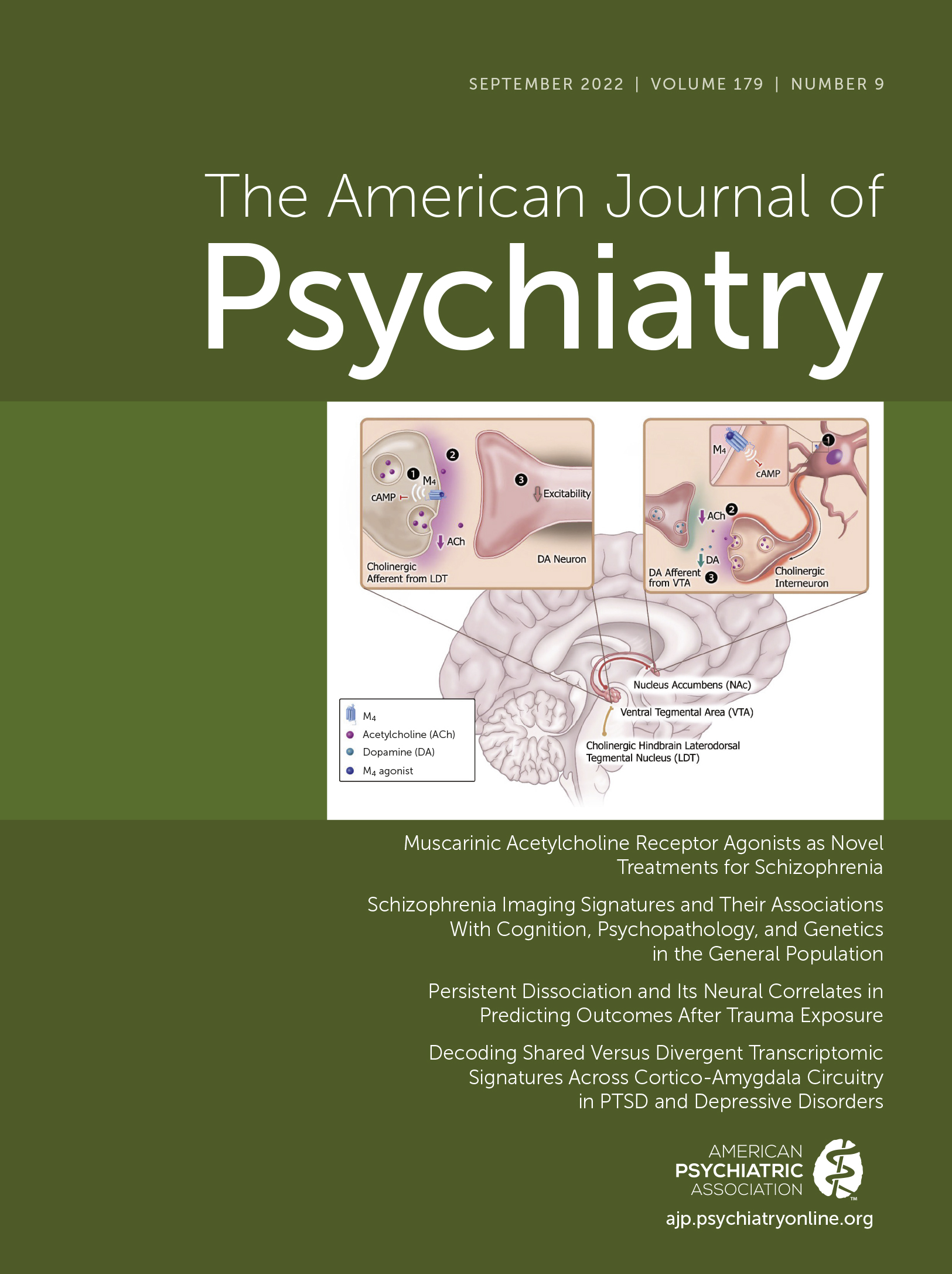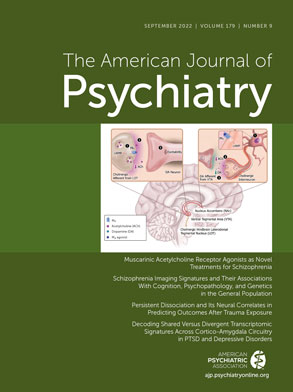Developmental Pathways and Clinical Outcomes of Early Childhood Psychotic Experiences in Preadolescent Children at Familial High Risk of Schizophrenia or Bipolar Disorder: A Prospective, Longitudinal Cohort Study - The Danish High Risk and Resilience Study, VIA 11
Abstract
Objective:
Methods:
Results:
Conclusions:
Methods
Participants
Measures
Psychotic experiences.
Mental disorders.
Global functioning, IQ, and pubertal stage.
Statistical analyses.
Results
Sample Characteristics
| Familial risk group | p | p Value for pairwise comparisons | ||||||||
|---|---|---|---|---|---|---|---|---|---|---|
| FHR-SZ (N=170b) | FHR-BP (N=103) | Control group (N=174b) | FHR-SZ vs. control group | FHR-BP vs. control group | FHR-SZ vs. FHR-BP | |||||
| N/mean | %/SD | N/mean | %/SD | N/mean | %/SD | |||||
| Female, N, % | 82 | 48.2 | 46 | 44.7 | 82 | 47.1 | 0.85c | NA | NA | NA |
| Age at inclusion, years, mean, SD | 12.0 | 0.3 | 11.9 | 0.2 | 11.9 | 0.2 | 0.61d | NA | NA | NA |
| Baseline IQe, mean, SDf | 103.0 | 11.3 | 105.3 | 8.8 | 105.2 | 9.8 | 0.07d | NA | NA | NA |
| Onset of pubertyg, N, %h | 137 | 87.3 | 87 | 90.6 | 151 | 94.4 | 0.09c | NA | NA | NA |
| Any early childhood psychotic experiences (age 7 years), N, % | 83 | 48.8 | 45 | 43.7 | 61 | 35.1 | 0.03c | 0.01 | 0.15 | 0.41 |
| Any early childhood axis I disorder (K-SADS, age 7 years)i, N, % | 61 | 35.9 | 36 | 35.0 | 28 | 16.1 | <0.001c | <0.001 | <0.001 | 0.88 |
| Any middle childhood axis I disorder (K-SADS, age 11 years)i, N, % | 82 | 48.2 | 40 | 38.8 | 39 | 22.4 | <0.001c | <0.001 | 0.003 | 0.13 |
| Current global functioningj, mean, SD | 64.8 | 15.6 | 68.5 | 14.6 | 75.1 | 14.0 | <0.001d | <0.001 | <0.001 | 0.05 |
| Educational level, primary caregiverk,l | ||||||||||
| Primary/lower secondary, N, % | 57 | 33.5 | 19 | 18.4 | 36 | 20.8 | ||||
| Upper secondary, vocational, short-cycle tertiary, N, % | 39 | 22.9 | 21 | 20.4 | 39 | 22.5 | 0.008m | 0.008 | 0.46 | 0.003 |
| Bachelor degree, equivalent or higher, N, % | 74 | 43.5 | 63 | 61.2 | 98 | 56.6 | ||||
Prevalence of Middle Childhood Psychotic Experiences
| N, % | Between-group comparisons | ||||||||||||||
|---|---|---|---|---|---|---|---|---|---|---|---|---|---|---|---|
| FHR-SZ (N=170) | FHR-BP (N=103) | Control group (N=174) | FHR-SZ vs. control group | FHR-BP vs. control group | FHR-SZ vs. FHR-BP | ||||||||||
| N | % | N | % | N | % | Odds ratio | 95% CI | p | Odds ratio | 95% CI | p | Odds ratio | 95% CI | p | |
| Four-year prevalence, any psychotic experiences | |||||||||||||||
| Unadjusted | 54 | 31.8 | 21 | 20.4 | 32 | 18.4 | 2.1 | 1.3–3.4 | 0.005 | 1.1 | 0.6–2.1 | 0.68 | 1.8 | 1.0–3.2 | 0.04 |
| Adjusted for sex | 2.1 | 1.3–3.4 | 0.005 | 1.1 | 0.6–2.1 | 0.68 | 1.8 | 1.0–3.2 | 0.04 | ||||||
| Six-month prevalence, any psychotic experiences | |||||||||||||||
| Unadjusted | 42 | 24.7 | 14 | 13.6 | 23 | 13.2 | 2.2 | 1.2–3.8 | 0.007 | 1.0 | 0.5–2.1 | 0.93 | 2.1 | 1.1–4.0 | 0.03 |
| Adjusted for sex | 2.2 | 1.2–3.8 | 0.007 | 1.0 | 0.5–2.1 | 0.91 | 2.1 | 1.1–4.0 | 0.03 | ||||||
Longitudinal Associations Between Early Childhood Psychotic Experiences and Middle Childhood Psychotic Experiences and Mental Disorders
| Early childhood psychotic experiences | ||||||||||||
|---|---|---|---|---|---|---|---|---|---|---|---|---|
| Any psychotic experiences (N=189) | One type of psychotic experiences (N=104) | Two types of psychotic experiences (N=48) | Three or more types of psychotic experiences (N=37) | |||||||||
| Odds ratio | 95% CI | p | Odds ratio | 95% CI | p | Odds ratio | 95% CI | P | Odds ratio | 95% CI | p | |
| Any middle childhood psychotic experiences | ||||||||||||
| Unadjusted | 1.9 | 1.2–2.9 | 0.004 | 1.6 | 0.9–2.7 | 0.10 | 2.1 | 1.1–4.2 | 0.03 | 2.6 | 1.2–5.4 | 0.01 |
| Adjusted for sex | 1.9 | 1.2–2.9 | 0.005 | 1.6 | 0.9–2.7 | 0.10 | 2.1 | 1.1–4.2 | 0.03 | 2.6 | 1.2–5.4 | 0.01 |
| Any middle childhood axis I disorder | ||||||||||||
| Unadjusted | 2.2 | 1.5–3.3 | <0.001 | 1.6 | 1.0–2.6 | 0.06 | 2.8 | 1.5–5.2 | 0.002 | 4.2 | 2.0–8.5 | <0.001 |
| Adjusted for sex | 2.3 | 1.5–3.4 | <0.001 | 1.7 | 1.0–2.7 | 0.04 | 2.8 | 1.5–5.3 | 0.001 | 4.3 | 2.1–8.8 | <0.001 |
| Adjusted for sex and any early childhood axis I disorder | 2.1 | 1.3–3.2 | 0.002 | 1.7 | 1.0–3.0 | 0.05 | 2.3 | 1.1–4.7 | 0.03 | 3.1 | 1.4–7.0 | 0.007 |
| Adjusted for sex, any early childhood axis I disorder, and familial risk | 2.0 | 1.2–3.1 | 0.004 | 1.8 | 1.0–3.1 | 0.04 | 2.0 | 1.0–4.2 | 0.06 | 2.5 | 1.1–5.7 | 0.04 |
Associations Between Developmental Pathways of Psychotic Experiences and Middle Childhood Mental Disorders
| Developmental pathways of psychotic experiences | |||||||||
|---|---|---|---|---|---|---|---|---|---|
| Remittent psychotic experiences (N=131) | Incident psychotic experiences (N=49) | Persistent psychotic experiences (N=58) | |||||||
| Odds ratio | 95% CI | p | Odds ratio | 95% CI | p | Odds ratio | 95% CI | p | |
| Any middle childhood axis I disorder | |||||||||
| Unadjusted | 2.0 | 1.2–3.2 | 0.004 | 2.3 | 1.2–4.3 | 0.01 | 4.9 | 2.7–9.1 | <0.001 |
| Adjusted for sex | 2.1 | 1.3–3.4 | 0.002 | 2.3 | 1.2–4.5 | 0.01 | 5.2 | 2.8–9.8 | <0.001 |
| Adjusted for sex and any early childhood axis I disorder | 1.8 | 1.1–3.1 | 0.03 | 2.1 | 1.0–4.3 | 0.05 | 4.5 | 2.3–9.0 | <0.001 |
| Adjusted for sex, any early childhood axis I disorder, and familial risk | 1.7 | 1.0–2.9 | 0.06 | 1.8 | 0.9–3.9 | 0.10 | 4.1 | 2.1–8.4 | <0.001 |

Interaction Between Psychotic Experiences and Familial Risk Status
Cross-sectional Associations Between Psychotic Experiences and Mental Disorders in Middle Childhood
Sensitivity Analyses
Discussion
Main Findings
Interpretation
Strengths and Limitations
Conclusions
Acknowledgments
Supplementary Material
- View/Download
- 547.09 KB
References
Information & Authors
Information
Published In
History
Keywords
Authors
Competing Interests
Funding Information
Metrics & Citations
Metrics
Citations
Export Citations
If you have the appropriate software installed, you can download article citation data to the citation manager of your choice. Simply select your manager software from the list below and click Download.
For more information or tips please see 'Downloading to a citation manager' in the Help menu.
View Options
View options
PDF/EPUB
View PDF/EPUBLogin options
Already a subscriber? Access your subscription through your login credentials or your institution for full access to this article.
Personal login Institutional Login Open Athens loginNot a subscriber?
PsychiatryOnline subscription options offer access to the DSM-5-TR® library, books, journals, CME, and patient resources. This all-in-one virtual library provides psychiatrists and mental health professionals with key resources for diagnosis, treatment, research, and professional development.
Need more help? PsychiatryOnline Customer Service may be reached by emailing [email protected] or by calling 800-368-5777 (in the U.S.) or 703-907-7322 (outside the U.S.).

